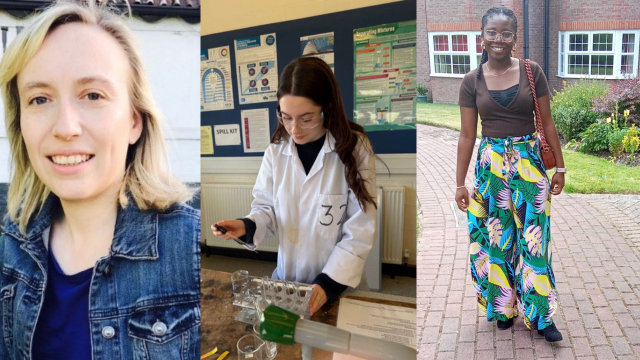
Every year on February 11, the world comes together to celebrate International Day of Women and Girls in Science, an observance recognised by the UN to promote the inclusion of women in Science, Technology, Engineering and Mathematics (STEM).
According to the 2024 Global Education Monitoring Report, there continues to be a persistent underrepresentation of women in STEM across the world, with only 35% of STEM graduates being female.
HSDC is a College with a strong commitment to diversity, equity and inclusion, and has been a consistent advocate for gender parity in STEM. For International Day of Women and Girls in Science, we spoke to female students and staff across the College, asking them about their experiences in STEM.
Dr Bianca Junge is a Lecturer of Psychology at Alton College and studied psycholinguistics as part of her psychology PhD:
Q: What inspired your passion for science?
“When I was younger I used to think that I wasn’t intelligent enough to understand science, but that all changed when I started my Psychology degree. I learned that it is not as difficult to understand as it sounds. I think when I was younger no one ever taught me how science works, the basics principles of having a theory, collecting data and finding evidence for a theory.”
Q: Who is your biggest female scientific role model and why?
“This has to be my former PhD supervisor Prof Elena Lieven who is one of the leading psychologists in the field of language acquisition research. She was one of the first female professors in the UK. In the 1970s female academics/scientists really had to fight to be recognised. Nowadays, Psychology is a scientific discipline that has a relatively high proportion of female researchers but back then it was a male dominated field. Elena had to work so hard, she paved the way for females in Academia and Psychology, which I find truly inspiring.”
Q: What is your advice for women and girls who want to pursue an education/career in science?
“Science is the foundation of all knowledge, without science we wouldn’t be able to make any progress. It is not as difficult to understand as it looks, everyone is capable of understanding it. You don’t have to have an A* in Maths to grasp the basic ideas of science. When I was in school, I wasn’t good at Maths and Science and I started to enjoy it when I learned about the practical applications of science (understanding why your car is not working is Applied Physics, for example).”
Q: What’s a fun science fact you think more people should know?
“When you’re in love, the same part of the brain is activated that is also involved in drug addiction.”
Chizitaram Favour Oji studies Biology and Psychology at HSDC, and wants to go on to become a clinical psychologist:
Q: What inspired your passion for science?
“My passion for science began with my desire to become a clinical psychologist, and it’s only grown from there! Studying psychology and biology at HSDC has really helped fuel this passion. ”
Q: Who is your biggest female scientific role model and why?
“My biggest role model would be Fatima Akilu. I admire her so much because of her role in promoting mental health awareness and support in Nigeria. She is a massive inspiration!”
Q: What is your advice for women and girls who want to pursue an education/career in science?
“Do not let anyone tell you what you can and cannot do. Never forget that you can do anything you set your mind to.”
Q: What’s a fun science fact you think more people should know?
“Octopuses have three hearts. Two of the hearts pump blood through the gills, whilst the third pumps it to the rest of the body. The heart that supplies blood to the body stops beating when the octopus swims, which is why they prefer crawling over swimming.”
Emily Groves studies psychology and chemistry at HSDC, and spoke about her love for the sciences:
Q: What inspired your passion for science?
“My main passion for science is to study psychology. This originally came from my fascination with the unknown, especially the mysteries surrounding the human mind. Questions like, ‘Why do we behave in certain ways?’ and ‘Why do we feel certain emotions?’ have inspired me to figure out exactly how the brain works.”
Q: Who is your biggest female scientific role model and why?
“My biggest female scientific role model is Rita Levi-Montalcini, one of the world’s first brain scientists. During the Second World War she was forced to study neurology in hiding whilst working as a military medical doctor. Long after the war, she was awarded a Nobel Prize for the discovery of nerve growth factor, opening the door for neurologists to attain a greater understanding. Going from studying neurology in secret to winning a Nobel Prize is such an inspirational story!”
Q: What is your advice for women and girls who want to pursue an education/career in science?
“Research as much as possible beforehand. What qualifications are needed? Does your degree need to be credited? What opportunities are there within modern science? Science is such a broad subject that continues to grow and expand, with new areas constantly being discovered. Your future job might not even be a job at the moment! There are so many paths into science, you just need to find the right one for you.”
Q: What’s a fun science fact you think more people should know?
“We are literally made of stardust – nearly all elements in the human body were originally made in stars and through supernovae.”
If you want to get into STEM, HSDC is the perfect College to enrich your education and give you a strong foundation of scientific knowledge! Find out more by clicking the link: https://www.hsdc.ac.uk/study/science-technology-engineering-maths/
To find out more about HSDC’s commitment to Diversity, Equality and Inclusion, please visit: https://www.hsdc.ac.uk/life-at-hsdc/equality-diversity-and-inclusion/